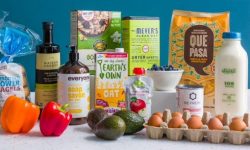Favourite Gluten-Free Items Available at Spud May National Celiac Awareness Month, but every day Spud…
Remember that time you moved out of your parents’ home, realized you had no idea how to cook anything besides toast, and floundered around your new kitchen whipping up strange concoctions until you finally found your culinary self?
Whether you like it or not, the time will come when your child will be out on their own, having to buy their own groceries, cook for themselves, and perhaps be scrambling around. There are, however, some incredibly useful tips that you can be teaching them now to help ease this process of when they do finally leave the nest. As someone who has already done this, I’ve got a few tips to share with you that kept me on track with a healthy lifestyle when I did eventually move out. These tips are perfect for young people living on their own for the first time, but are also staple tips that can be useful at any age–so don’t forget to lead by example!
1. Instead of focusing on what they shouldn’t eat, get them excited about eating more whole foods.
Don’t be the person who walks around only seeing what they know they shouldn’t be eating–it’s much too stressful. Instead, teach your children to focus on (and get excited about) which foods they should be adding. Encourage them to incorporate as many whole foods, meaning unprocessed or unrefined, as possible. This includes fruits, vegetables, whole grains, proteins, and good fats. When you’re more focused on the nutritious food you’re eating, you have less time to think about all the junk food you’re missing out on!
2. Help them figure out which healthy foods they love.
It’s good practice to go into meal planning thinking, ‘what do I like, and how can I build healthy meals around this?’ Say you’re a fan of avocados–avocado toast, avocado smoothies, avocado on eggs, pasta, or in salads! Help them figure out which whole foods they’re into, then show them all the ways they can cook healthy meals with that food in mind.
3. Encourage them to stock their living space with healthy snacks.
Living in a dorm can certainly uproot some healthy lifestyle habits, but it’s all about prep. Trust me, late-night studying can evoke an almost animal urge for chips and sugar, but the convenience of having a few healthy snacks in my dorm cupboard abolished my need to wander out in search of junk food. My favourite brainfood snacks to stock up on are apples, carrots, hummus, peanut butter, nuts and oatmeal.
4. Stress the benefit of keeping an emergency snack in their backpack.
Hanger (hungry anger) is a real thing, and it often results in making rash food decisions. Keeping an emergency granola bar or an apple in your bag is a godsend when you find yourself stuck on the bus, with a stomach grumbling in class, or having to stay at the library later than you’d thought. However, choose granola bars carefully. Many are loaded with added sugar. Look for bars with short ingredient lists filled with foods you recognize, at least 10 grams of protein, 5 grams of fiber, and no added sugar.
5. Teach them how to sneak protein into meals and snacks to stay fuller longer.
When you begin removing processed foods from your diet, and include more whole foods and fresh produce, you will likely find that you are naturally receiving enough protein and fibre. However, some tips of mine include adding some peanut butter or avocado to a smoothie in the morning, sprinkling a handful of nuts and seeds onto your salad, and the ultimate student protein-filled and budget-friendly combo–beans and whole grains. Try experimenting with some easy protein-rich recipes: Easy Brown Rice and Beans, Vegetable and Lentil Soup, Feta and Chickpea Salad, or Quinoa and Smoked Tofu Salad–the list goes on!
6. Get them into the habit of filling half their plate with salad or veggies first.
When your kids have to adjust to the meal plan of dorm life or have to start cooking their own meals, they will do well if they are already in the habit of filling up their plate with veggies first. This can become something that will stay with them when they’ve got a whole cafeteria full of options–healthy and unhealthy–to choose from.
7. Teach them to avoid the sugary drinks, and to get used to bringing a reusable water bottle with them.
Drinks are often overlooked when we think about junk food, but soda, fruit juice, and even sports drinks pack a ton of sugar that can be easily avoided by simply hydrating with water. Think of these drinks as treats, and try to break out of the habit for grabbing one when thirsty–what your body really wants is water.
A great tip to follow when trying to limit sugary drinks, use less plastic, and save money! Getting into the habit of having your water bottle with you will keep you properly hydrated, reduce your intake of junky beverages, and will prevent you having to buy any plastic water bottles.
8. Make sure they know what kind of cereal to look for.
Cereal is a fairly classic staple food acceptable for breakfast, lunch or dinner when you’re away at school and cramming for exams. If stuck in the cereal rut, and I don’t encourage it, at least make sure that you’re buying cereals with whole grains as the primary ingredient and with 10 grams or less of added sugar per serving.
9. Teach them how to cook big batches of food for themselves that can be stored.
Another vital tip for students: make big batches of food that will last a few meals. Cooking for one can be magically simplified if you find meals that keep well, and that you’re interested in eating for lunch or dinner again the next day. That said, leftovers are much more appetizing when they haven’t absorbed the many smells of the fridge. Invest in some good, glass storage containers to keep your leftovers fresh! Some great big batch meals include Simple Chili, Pasta with Roasted Asparagus, Tomatoes and Capers, Slow Cooker Coconut Quinoa Curry, and Savoury Lentil and Carrot Soup.
10. Make sure they know how to cook whole and ancient grains like brown rice or quinoa.
Having a good supply of grains handy will make assembling healthy meals that much easier. Big batches of quinoa can be stored for a few days, and thrown into salads, soups, or stirfrys to add some protein. Grains are also an economical choice as they can be stored for a very long time, and are cheaper to buy in bulk!
12. Get them to start making their own lunch now.
When you pack your own lunch, it’s likely healthier, you can control portions, and you’re saving money! If you get your child in the habit of making their own lunch now, you can rest easy that they’re going to do a good job of it while they’re away. Making big batches, or bringing leftovers makes it easy to put a quick lunch together.
Learning how to cook for yourself is an incredibly important part of growing up, so encouraging your kids to pick up some good habits now will have them thanking you when the time finally comes. What were some tips that you picked up when you started to cook for yourself?




